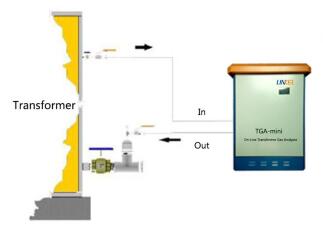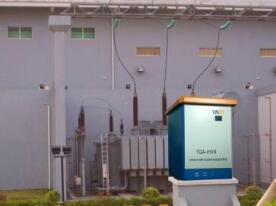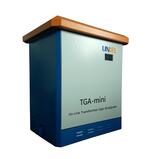
Accuracy or tolerance: when valve
Environment temperature: -40℃ ~ +55℃
Oil temperature: -40℃ ~ +110℃
Oil temperature: -40℃ ~ +110℃
Humidity: 10 ~ 100% RH, without condensation
Oil pressure: while running,0~3bar (0~45psi); Others, -1~+6bar(-15~+87psi)
Communications: USB,RS232,RS485,Modem
Power: 90~250VAC, 47~63Hz, 150W
Alarm output: 5A/250VAC; 5A/30VDC
Sampling period: 1~24 Hours
Dimension: 800×700×500mm
Weight: 20Kg


★ Fast measuring in the field
Within 20 minutes, 3 key fault gases and moisture can be read.
★ No consumables
Pure physical photo-acoustic spectroscopy technology, The consumables of calibration gas and carry gas are needless.
★ Moisture in the oil
The concentration of moisture in the oil can be given during the same one test, accuracy ±1ppm.
★ Simple
Step-by-step software guides and touch screen,the user pass through the procedure.
★ Reliable
Engineered design provides inherent reliability and high accuracy.
★ PC communication
PC software allows downloading,trending and analysis of results.
★ Sample Period
The sample is adjustable,and the minimum period<1hour.
★ Reliable Gas Extraction
No use of membranes or vacuum extraction.
Test equipment for analysis the dissolved gas in transformers oil
THEORY:
The photo-acoustic effect is caused by the ability of a gas to absorb electromagnetic radiation (e.g. infrared light).In absorbing the radiation the temperature of the gas will increase and,if the gas is held in a sealed container,this temperature rise will produce a proportional rise in pressure.If the light source is pulsed the pressure of the gas fluctuates in sympathy and these pressure waves can then be detected using sensitive microphones.
There are two key facts that permit this effect be used for analytical measurements.The first is that each gas has a unique absorption spectrum,thereby allowing the frequency of the infrared source to be tuned to excite a given substance.The second is that the level of absorption is directly proportional to the concentration of the given gas.
Therefore by selecting an appropriate wavelength and measuring the level of the resultant signal it is possible to detect,not only the presence but also the concentration of any given gas,even in a complex cocktail of other compounds.This forms the central principle of Photo-Acoustic Spectroscopy (PAS).
After the gas is extracted from the oil by controlled excitation of the sample it is then analyzed using photo-acoustic spectroscopy,the same method used by the European Space Agency for monitoring blood gases.



